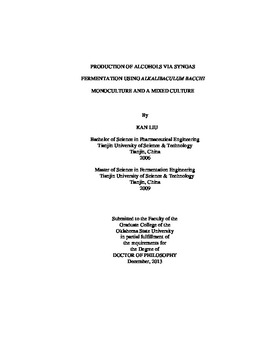| dc.contributor.advisor | Atiyeh, Hasan K. | |
| dc.contributor.author | Liu, Kan | |
| dc.date.accessioned | 2015-06-17T20:06:47Z | |
| dc.date.available | 2015-06-17T20:06:47Z | |
| dc.date.issued | 2013-12 | |
| dc.identifier.uri | https://hdl.handle.net/11244/14974 | |
| dc.description.abstract | Gasification-syngas fermentation is a hybrid conversion technology. In this process, feedstocks such as biomass or municipal solid waste are gasified to syngas (CO, H2 and CO2), which is then converted into biofuels and chemicals using biocatalysts. Recently isolated Alkalibaculum bacchi strains CP11T, CP13 and CP15 were found to convert CO and H2) into ethanol and acetic acid at initial pH 8.0. Bottle fermentations showed that CP15 was the most promising strain for ethanol production because of its higher growth and ethanol production rates and yield than CP11T and CP13. The cost of CP15 medium was reduced by 27% by removing TAPS buffer and replacing yeast extract (YE), minerals and vitamins with corn steep liquor (CSL). The use of CSL resulted in a twofold increase in ethanol production in bottle fermentations. Fermentations were scaled up to 3-L and 7-L fermentors in semi-continuous and continuous modes with and without cell recycle. Results of the continuous syngas fermentation with cell recycle showed a maximum of 5.5 g/L cell mass concentration at a dilution rate of 0.033 h-1 in the YE medium. Cell mass and ethanol concentrations were 2.2 g/L and 6.5 g/L, respectively, at a dilution rate of 0.011 h-1. When CSL medium was used in continuous syngas fermentation, the maximum produced concentrations of ethanol, n-propanol and n-butanol were 8 g/L, 6 g/L and 1 g/L, respectively. n-Propanol and n-butanol were not typical products of strain CP15. A 16S rRNA gene-based survey revealed a mixed culture in the fermentor dominated by A. bacchi strain CP15 (56%) and Clostridium propionicum (34%). The mixed culture presents an opportunity for higher alcohols production from syngas. Semi-continuous fermentations in a 3-L fermentor with the mixed culture and CSL medium resulted in a twofold more total alcohol production than in the YE medium. The synergy between strain CP15 and C. propionicum in the mixed culture in bottle fermentations resulted in 50% higher efficiency in converting propionic acid, butyric acid and hexanoic acid to their respective alcohol. | |
| dc.format | application/pdf | |
| dc.language | en_US | |
| dc.rights | Copyright is held by the author who has granted the Oklahoma State University Library the non-exclusive right to share this material in its institutional repository. Contact Digital Library Services at lib-dls@okstate.edu or 405-744-9161 for the permission policy on the use, reproduction or distribution of this material. | |
| dc.title | Production of alcohols via syngas fermentation using Alkalibaculum bacchi monoculture and a mixed culture | |
| dc.contributor.committeeMember | Fathepure, Babu Z. | |
| dc.contributor.committeeMember | Huhnke, Raymond L. | |
| dc.contributor.committeeMember | Wilkins, Mark R. | |
| osu.filename | Liu_okstate_0664D_13006.pdf | |
| osu.accesstype | Open Access | |
| dc.type.genre | Dissertation | |
| dc.type.material | Text | |
| dc.subject.keywords | alcohols | |
| dc.subject.keywords | alkalibaculum bacchi | |
| dc.subject.keywords | butanol | |
| dc.subject.keywords | ethanol | |
| dc.subject.keywords | mixed culture | |
| dc.subject.keywords | syngas fermentation | |
| thesis.degree.discipline | Biosystems and Agricultural Engineering | |
| thesis.degree.grantor | Oklahoma State University | |
